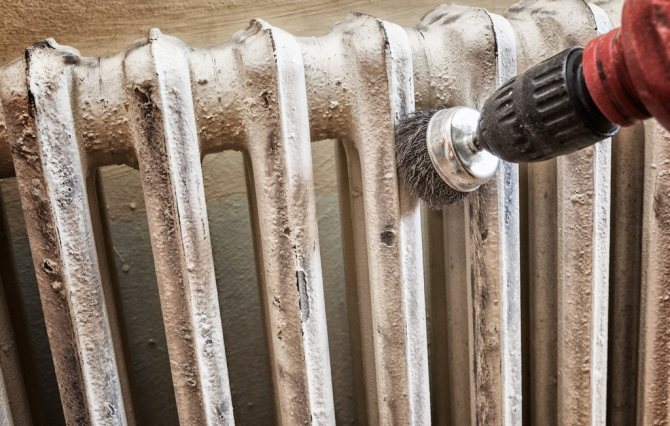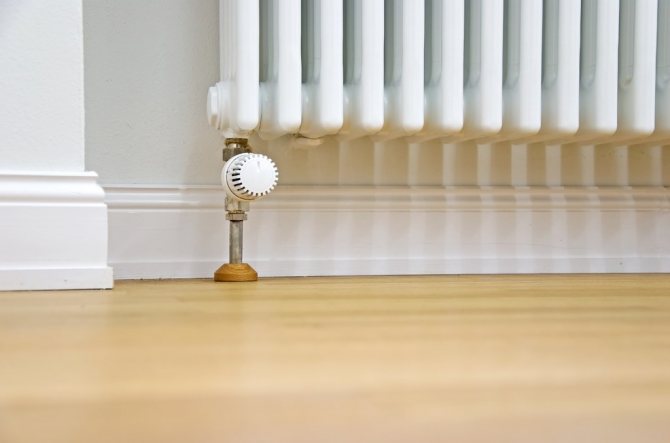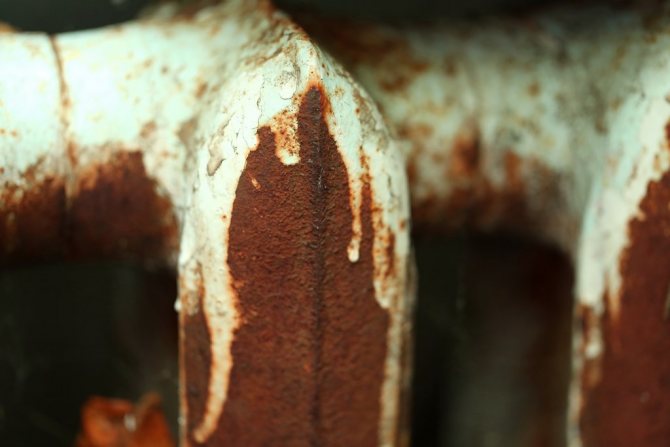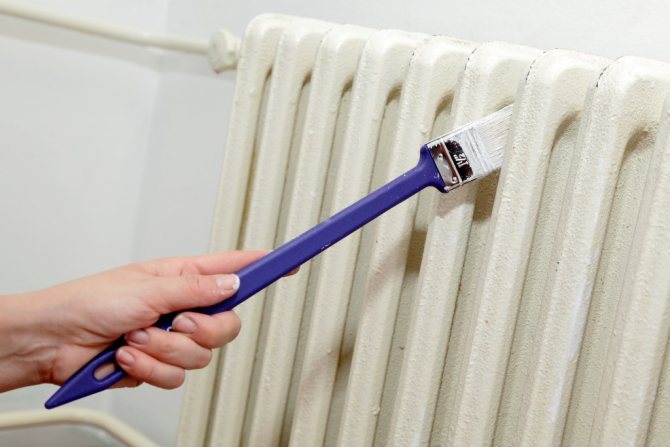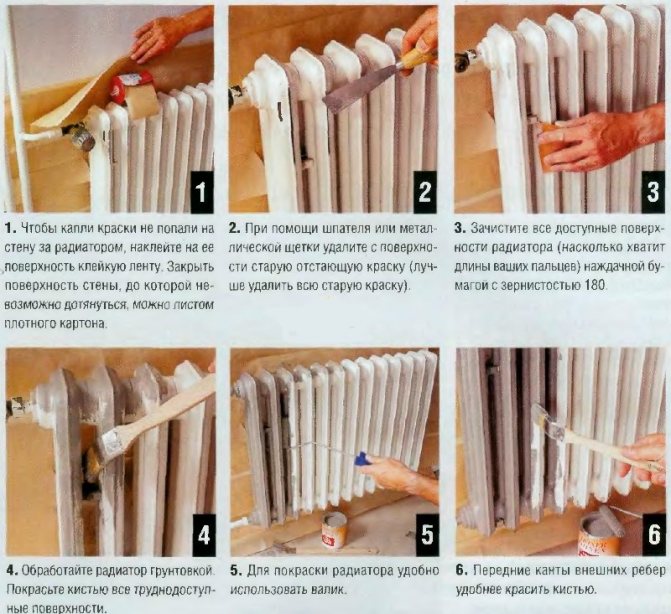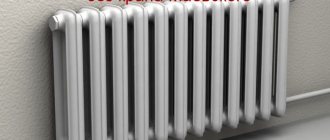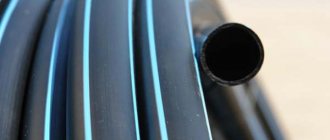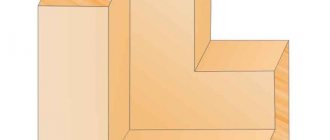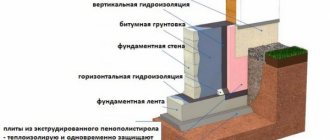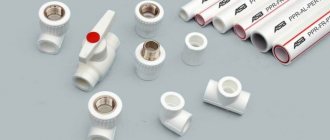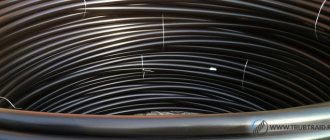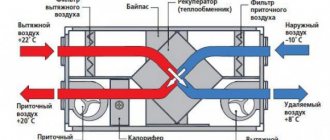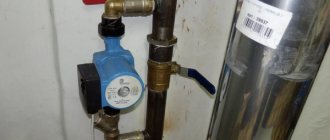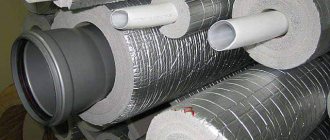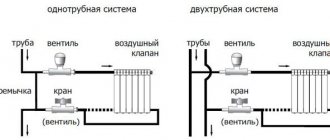Selection features
The radiator brush is one of the varieties of painting tools specially designed for painting the bends of a cast-iron battery. Not every such tool can perform a similar procedure.
The radiator brush is characterized by the presence of a long handle, medium hardness of the pile and a sharp tip. Then it will be possible to cover the entire area of the battery with a layer of paint, getting to hard-to-reach places. On the advice of experienced craftsmen, it is better to use several types of such products.
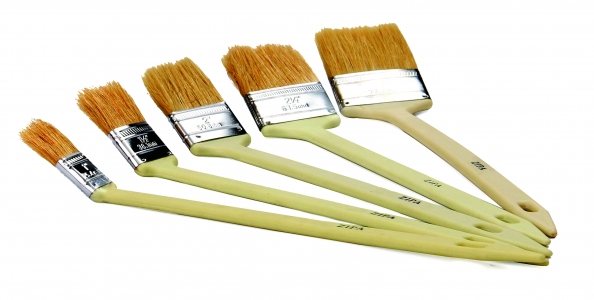
Types of paint
Many years ago, heating systems were covered with oil paints. After a few years, they cracked, the batteries were painted with their own hands with the second, third ... and subsequent layers. As a result, after 30 years, heating radiators, reliably insulated with a thick layer of paint, practically stopped heating. The modern assortment of paints for batteries is very large and allows you to cover heating devices with your own hands with a thin durable coating of a wide variety of colors, while the durability of the coatings can reach 10 years.
A brief description of the various paints is given below.
Acrylic
Acrylic dyes have appeared relatively recently. The most common acrylic paints are an aqueous emulsion of acrylic resin and pigment particles suspended in water. After drying, acrylic resin merges into one mass, forming a durable wear-resistant layer that firmly holds the pigment in itself.
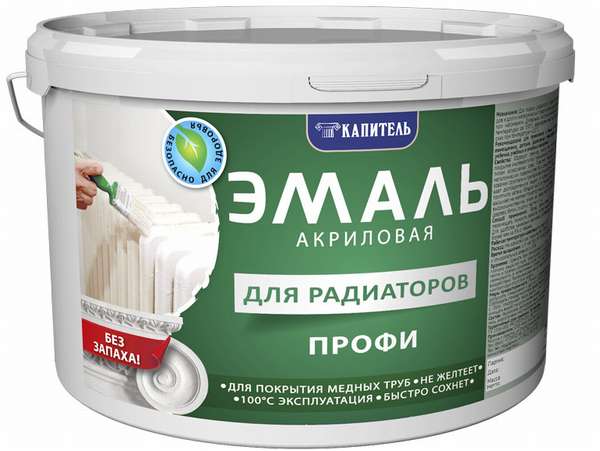

Pros:
- The coating is smooth, uniform and slightly plastic-like.
- The bright color of the battery will remain unchanged for 7-8 years, the white will not turn yellow, the paint perfectly tolerates the elevated temperature of the heating system, does not crack or flake off.
- After drying, the coating becomes insoluble in water and in most solvents, it is not afraid of moisture.
- It is especially worth mentioning that the acrylic mixtures on the battery dry in literally half an hour, while there is no sharp, irritating smell to the respiratory tract and eyes, like other paints.
- The good adhesion of acrylic resin allows it to be used for painting both steel and aluminum surfaces for heating. There are varieties of acrylic paints based on organic solvents, the quality of the resulting surface of these paints is better than that of alkyd and water-based acrylic paints, color fastness is also excellent.
Alkyd
Alkyd paints have anticorrosive properties, good adhesion, elasticity, high temperature resistance, form an even smooth coating on the battery, superior in strength to acrylic resin.
Minuses:
- Alkyd compounds dry out within a day, the evaporating solvent has a pungent unpleasant odor and disappears within a few more days. After painting the battery, the room must be intensively ventilated. It is impossible to be in it - the solvent (especially when the heating is on) is not harmless to humans.
- The second significant drawback of alkyd compositions is the low color fastness, after 3-4 years the white color will begin to turn yellow, and the color color will lose its brightness. It is better to choose a glossy paint - it will keep the whiteness or brightness of the color on heating devices longer.
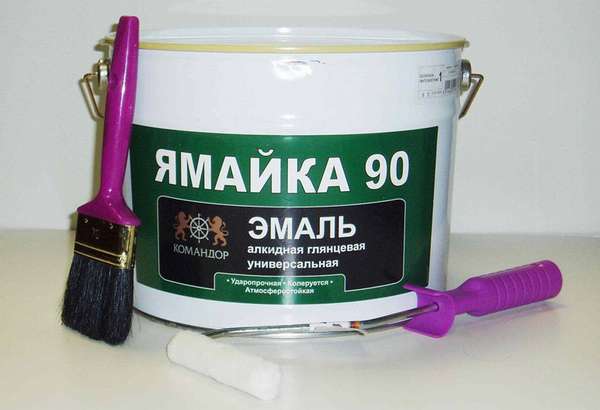

Hammerheads
This is a modern type of acrylic compound. They form a very durable original coating with an interesting texture. The surface looks like it has been smashed with a small hammer and painted.The uneven, "speckled" surface well hides the chips of the battery - this is especially true for rough iron casting.
Other types of paint
For painting radiators with their own hands, they often use silverware - a suspension of aluminum powder in varnish. Serebryanka forms a durable coating that is resistant to high temperatures and abrasion. It can be applied over primer and old coatings.
Disadvantages:
- Strong persistent odor.
- The mixture is explosive and should be handled with care.
In addition, a radiator of a specific "aluminum" type will not fit into every interior.
For heating devices, compositions based on silicone resins are also used. They form a dense and elastic coating, resistant to abrasion and very high temperatures during heating. Moreover, the elasticity does not depend on the aging of the composition. Silicone compounds have high adhesion to any surface, they do not require preliminary priming. These paints also smell very unpleasant when they dry.
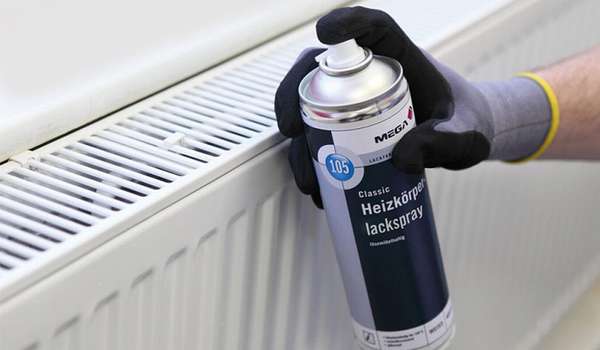

The most durable elastic coating is formed by polyurethane paints. This paint is a complex suspension of pigments and vinyl chloride copolymers in polyurethane compositions. Polyurethane paint is used to protect heating structures in open air and in industrial workshops. It has high temperature resistance, high resistance to humidity. For interior work, a two-component paint is used, which forms a beautiful glossy finish.
Epoxy and pentaphthalic enamels are also used for heating devices.
Using the handbrake
This tool is characterized by a round shape. A metal rim connects the bristles to the handle. It is the length of the handle that is an important factor in the successful operation of the tool. The pile length can be more or less short. In the case of using a brush with too long bristles, a rubber wrap is practiced. This simple trick will help in reducing the area of the bristles. Then the paint will be applied more accurately, it will not smudge.
Using a handbrake is a good starting point for painting if the object has wide sections. Such a tool has a diameter of 25 - 50 mm. Experts believe that the best choice is a brush with bristles up to 38 mm in length. Then the painting will take place quickly and without splashing.
What color should I choose?
During socialism, batteries were painted green - rust is best visible on a green background. The sooner you notice, the sooner you stop the corrosion.
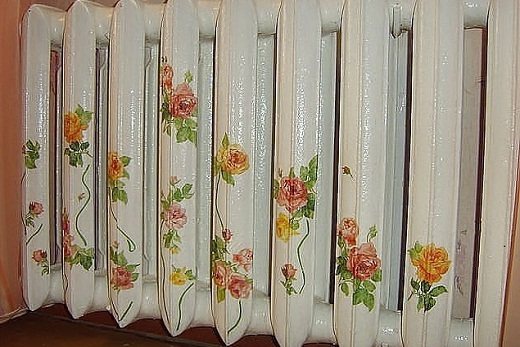

Coloring page radiator radiator with flowers
Then silver and steely colors came into fashion, then bronze and gold. Aluminum and bimetallic batteries are painted creamy white.
But batteries, as a rule, are located - whether in the hall, in the bedroom or in the kitchen - in a conspicuous place, and creative battery painting ideas can improve, make the interior of the room more stylish.
A favorite theme when painting cast-iron batteries is "zebra": section black, section white, section black, section white; we paint the pipe under the "tail". More inspired apartment owners draw flowers on high stalks on the battery sections, standing on the hind legs of meerkats, or even paint them like a Khokhloma. There are countless talents in Great Russia.
Classic Radiator Brush
This tool communicates its purpose by the very name. The radiator brush is an excellent product for painting hard-to-reach areas of a cast-iron battery. With the help of a long handle, the device easily falls into bends and crevices. Pile quality ranges from medium to hard.
The bristles of the brush are 20-100 mm in length. Radiator brush 50 mm long is the best option for successful work.
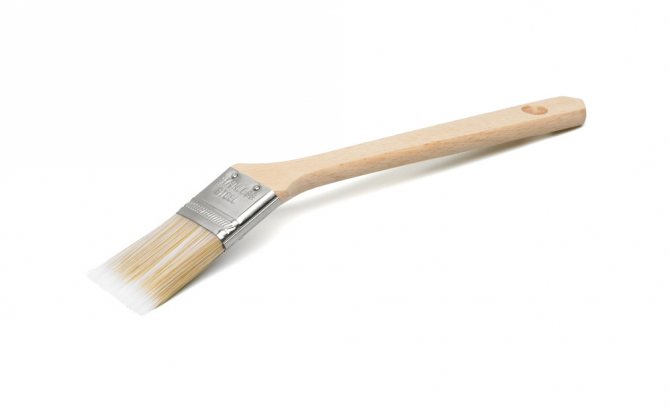

Radiator screens
By their design, they are hinged flat boxes that correspond to the size of the radiator. They can be performed:
- Made of plastic - economy design. They are considered the simplest and most inexpensive, but at the same time they can imitate any patterned surface. There are plastic screens for wood, marble, onyx, granite, brick or other materials.
- Wooden screens are more expensive, but they also look more spectacular.
- Metal grilles can be with any decorative pattern and represent a work of art in themselves.
- Glass screens are the most fragile and expensive way to "hide" cast iron batteries, especially if they are stained glass.
The screen can be matched to any style of interior, and in case of changes, just install a new one.
Today, many people are interested not in how to paint cast-iron heating radiators, but in how to make them truly beautiful and stylish. In modern design, these devices have become an interior decoration, conveying the individuality or financial well-being of the owners.
Expert advice
In order for the staining of batteries to be of the highest quality, it is recommended to heed the recommendations offered by professional painters. The tips are pretty simple but effective:
- Painting is carried out in the warm season, when the heating system is not used. On a hot surface, the paint will flow and will not stick. Using this tip will help to ensure even paint application and a neat appearance of the painted radiator.
- When buying a brush, it is important to study which company is its manufacturer. The goods must be supplied with a quality certificate in accordance with GOST standards. This advice will allow you to avoid buying a low-quality tool, the fluff of which may remain on the painted surface. Or a low-quality tool will surprise you with the departure of the metal rim, the weak attachment of the handle. Careful attention to the choice of the tool will save you from the listed troubles.
- Despite the direct purpose of the radiator brush, which implies painting the battery, for greater efficiency it is recommended to use several types of such tools of different sizes. For hard-to-reach places, choose a curved narrow brush, and paint over the outer surface with a wider brush.
- The choice of brushes with natural bristles will allow you to get a better finish, while synthetic bristles have a longer service life. Such products are more durable.
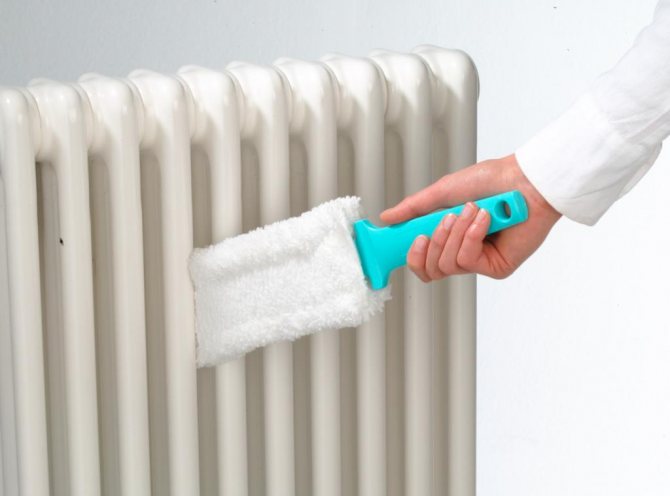

Heating battery painting rules
Choice of paint
So, what kind of paint should you choose if you have a desire to independently transform the interior of your apartment? The main rule is that it is necessary to choose from paints specially designed for batteries, since it is made so that it is resistant to high temperatures, an aggressive environment, does not wear off for a long time and does not emit toxic substances when heated.
There are several types of paint for heating batteries:
Alkyd. This paint will make the surface of the battery resistant to high temperatures and will hold for a long time. Its popularity among buyers is facilitated by a very wide range of colors that exist on the market. But this paint has a big drawback: for some time after staining and when the battery heats up, it emits a very unpleasant odor.
How to paint batteries with such paint and is it worth it? Well, most likely she can paint in some kind of institution where there is no need for people to stay for a long time. For example, in factories - where a large area allows the smell to simply disappear.
Acrylic. Coated batteries have a beautiful shiny surface that can last for a very long time.Among the disadvantages of paint can be called a pungent odor emitted by the solvent that is part of its composition, when it dries.
Water-dispersive. This is the best choice for the buyer. This paint does not smell, it dries almost instantly. When choosing, be sure to see if there is a marking on the label that informs about the suitability of paint for batteries and pipes.
Oil. This type of paint has already lost its former popularity, it has been ousted from the market by new and better compositions for coloring, therefore it is used very rarely.
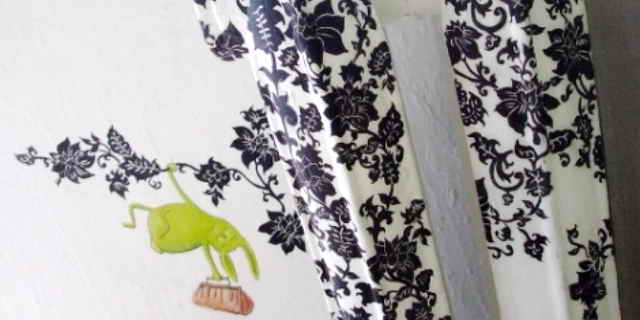

Painting works
In addition to the intricacies of choosing a paint radiator brush, it is important to take into account the peculiarities of painting work. The advice of experts will also help here:
- When starting work, the tool is soaked using warm water and soap solution. This softens the pile, removes dust and dirt, and the paint becomes smoother and softer.
- The paint must be pre-prepared in the required amount, which will be sufficient for the painting work.
- If you combine several paints of different colors and production, the result can upset the painter. Then, in addition to the spoiled product, the surface will also be poorly painted.
- In order for the result to be of high quality and durable, the radiator is painted in several layers. It is recommended to start work from the top of the battery.
- To preserve the brush, it must be cleaned of paint as soon as possible. For this purpose, a special solution is used. The tool is washed with kerosene, and then the remnants of this liquid are washed off with soapy water. The dried brush must be wrapped in paper to ensure long-term storage of the tool.
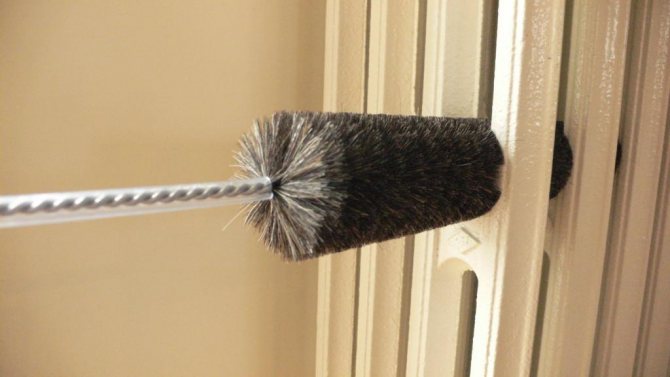

Preparing a cast iron battery before painting
This process is one of the most important. It should be approached with special responsibility, since all mistakes made in the course of its implementation can necessarily affect the quality of staining and the appearance of the battery.
Important! Work can be carried out only after the end of the heating season.
Methods for removing dust and grease
The first step is to cleanse the radiator from the dust and dirt present in it. To do this, you can use a vacuum cleaner or brush, as well as resort to using water with a detergent composition. If there are grease deposits on the batteries, then it is necessary to rinse it with an ordinary dishwashing detergent. Next, you need to wait for final drying, after which you can proceed to the next stage.
Then it is required to remove rust and old cracked paint that is present on the surface of the battery. To do this, you can use one of two methods - mechanical and chemical. The first one is quite laborious and in the course of its application you have to spend a significant amount of time. In the second case, cleaning is an order of magnitude easier, but when using chemicals, it is necessary to take into account a number of certain nuances, which will be discussed further.
Removing old paint from a battery mechanically
Removing paintwork using this method requires a metal brush to rub on the radiator. When cleaning the battery with this tool, it takes a lot of time and exerts a significant amount of effort, which is why it is better to resort to using a grinder with a special nozzle installed.
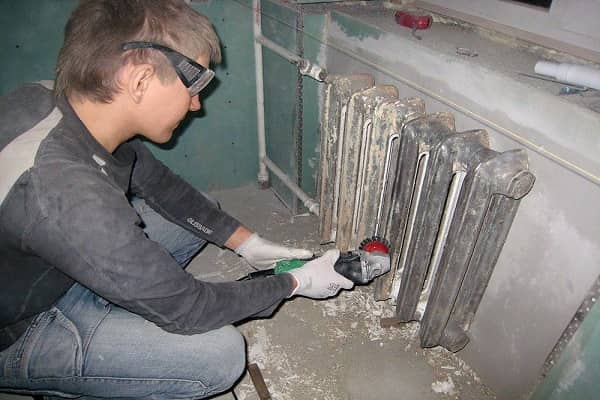

Using it, you can remove the old coating in a few hours, but you should be careful and take into account that you cannot operate the device at high speeds, especially if the batteries are made of non-ferrous metals. In this case, there is a possibility of imperceptible damage to the surface of the radiator.
Note! It is not necessary to completely remove paint from the battery.Smooth areas with no cracks can be opened with a new layer of the coloring composition.
Removal of coating with chemical mixtures
In this case, the paint is removed using special agents produced as a gel, paste or aerosol. Giving preference to the first two, they should open the entire surface of the battery with a brush with natural bristles, after which, to obtain the best effect, it is required to cover the radiator with polyethylene.
The exposure period varies according to the formulation used and usually ranges from 15 minutes to several hours, as detailed on the container label. After softening the paint, it is required to clean it with a spatula, and the rest with a metal brush.
Sprays are comfortable to use during application, since they can easily be used to treat even hard-to-reach areas of the battery.
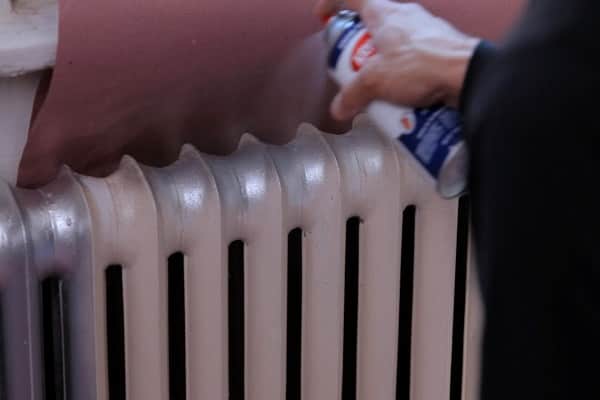

They work in the same way as gel products, so that after a certain period of time (usually 15 to 40 minutes), the paint becomes soft and can be easily removed with a brush.
Note! Before using chemicals, it is necessary to close the furniture present in the room, as well as the walls and floors.
In addition, giving preference to such compositions, one must take into account their disadvantages. First of all, they emit a pungent unpleasant odor, which is why the application of mixtures must be done in a room with full ventilation, as well as wearing protective gloves and a respirator.
In the second case, it is not known how the metal will manifest itself in the course of interaction with aggressive chemicals. There is a possibility that they can react, and after using them, damage is found on the surface.
Old cast iron batteries are not afraid of modern chemical compositions, but it should also be borne in mind that earlier heating devices were often compacted with hemp, which, under the influence of chemistry, can easily corrode.
As a result, when the heating is turned on, water may flow from all the connections, so you should decide on your own how to remove the old paintwork from the battery.
Opening the surface with a primer
After the removal of the old paint is completed and before the start of painting the heater, a number of actions must also be carried out. To eliminate cracks, scratches and other small defects, smooth surfaces made of steel or copper, it is required to go through with sandpaper. It is better to clean cast iron batteries with a metal brush.
Then you should degrease and apply a primer. When choosing a primer mixture, it is required to select a composition that is intended for metal, having anti-corrosion qualities and compatibility with paint.
Flute brush
This tool has a comfortable grip. Badger hair is used to make bristles. The radiator flange brush has a flat shape with a length of 25 - 100 mm. This tool is ideal for removing sagging from other brushes. Since experts recommend using several types of tools, this option will work well with a curved brush.
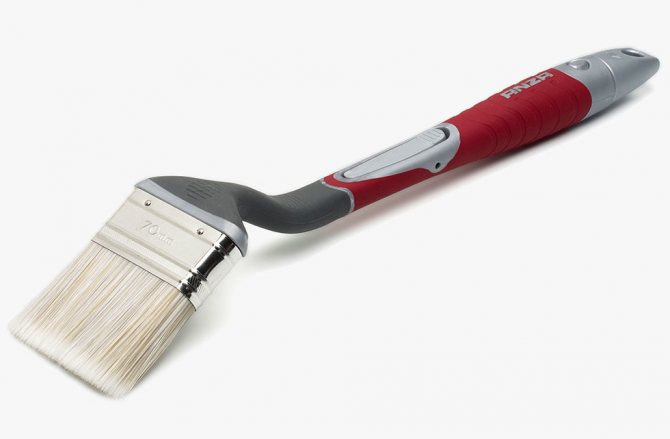

Battery staining process
Initially, it is recommended to observe the following rule: it is better to open the radiator with 2 thin coatings of paint than 1 thick one.
The first time there is a low probability of perfectly high-quality application of the coloring composition. If the paint is applied in a thick coating, the effect will be the opposite, as in this case, thick and unattractive smudges will occur.
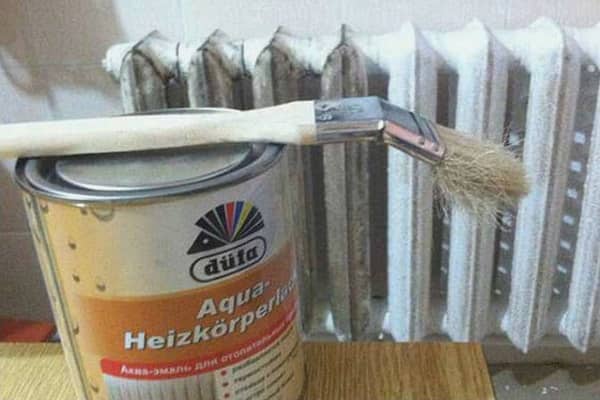

For painting, you need to buy at least two paint brushes: one ordinary, the other for opening hard-to-reach areas with an elongated curved handle, through which it is comfortable to handle the rear walls and inner surfaces of the radiator with a mixture. Before applying paint, you need to fluff up the pile of the tools used so that insufficiently well-retained hairs fall out.
The first step is to open the upper sections inside the heater with paint, and then those located below. Then you can start painting the outside of the battery. It is also required to apply paint on it from top to bottom. Re-painting should be carried out only after the complete drying of the previously applied layer, which is mainly indicated on the container with the mixture used. If, after the first opening, irregularities and smudges remain on the surface, then at the end of the curing of the coating, such defects must be removed with sandpaper. Following this, removing dust and dirt formed during the previous process, you need to apply a second layer of paint, on which the painting process can be considered complete.
Having learned how to paint a cast-iron battery at home and by observing all the steps and actions described above in the course of work, it will be possible to achieve a high-quality result and avoid possible mistakes.
Video:
Form matters
Most people have to manage their resources sparingly with old tools. This is not the correct method. Such savings are not rational, as they take a lot of time and effort. Instead of a small brush with round bristles, it is better to use a large, flat brush, which can paint an impressive area of the surface with a single stroke.
A small round brush is best when painting a small work surface. Such a tool is used to cover areas of special places, for example, round pipes.
Hard-to-reach places are painted with so-called corner brushes. This saves a lot of time.
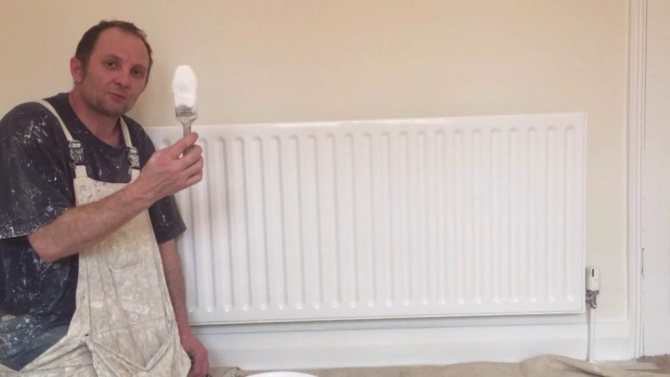

Preparation for work and painting
In order to figure out how to paint a radiator, you need to know the principle of this work.
As with any type of work in the construction industry, painting is done only after surface preparation. First of all, you need to remove dirt and inspect the product for corrosion.
After removing the old layer of paint and dirt, the battery must be washed with a cloth dampened in water. Places of swelling must be cleaned with sandpaper; if rotten areas are found, be sure to eliminate them.
At the final stage of preparation, the entire surface of the radiator must be covered with a primer. If a material will be used for painting that does not require the application of a primer, then this stage is skipped.
For a homemade solution, you need to prepare:
- 1 kg of soda ash;
- 1 kg of slaked lime;
- 5 liters of water;
- 10 liter capacity.
Preparing the solution is simple. Soda dissolves in water at a temperature of 60 degrees. After its complete dissolution, lime is added in small portions. It must be introduced strictly gradually so as not to lead to the formation of a large amount of foam.
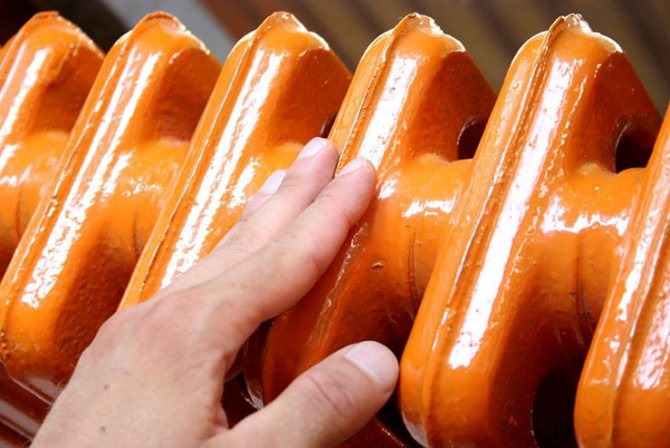

To paint the batteries yourself, you need some material.
With the mechanical method, sandpaper or a special scraper is used. It is rather difficult and time-consuming to clean the surface manually. You can use a special drill attachment or grinder. In this case, you must strictly follow the safety rules and act very carefully so as not to damage the battery.
We offer you to familiarize yourself with the best quality shower enclosures manufacturer
Thinking about how to paint a hot radiator and whether it can be done without special skills, you should not be afraid. Even a beginner can cope with this, it is enough just to know the basic rules of work.
Before painting, you need to prepare the workplace, lay polyethylene or newspapers on the floor, protect the wall by attaching thick paper or cardboard to it, and prepare tools.
The paint is applied with a brush in smooth movements from top to bottom - this way you can paint warm batteries without leaving streaks. The layer must be made thin and uniform. After the first layer has dried, the second is applied.
It is recommended to paint the inner surfaces of the battery first so as not to get your hands dirty during the process. If it is difficult to do this with a brush, then you can use a small roller or even an old toothbrush with a bendable head.
Stayer
It is made of natural bristles with a light color. The dimensions of the radiator brush of this model are 50 mm. Natural wood was used for the manufacture of the handle.
Thanks to the elongated shape of the tool handle, you can paint over all areas of the battery as comfortably as possible. This brush is best used with solvent-based paints.
Thanks to the special ergonomic shape, which is characteristic of the handle, the paint will not flow on the hands. It is convenient, simple and reliable to work with such a tool. This shape also guarantees a comfortable grip so that the tool does not slip out of your hands.
For the handle itself, a solid wood material is selected so that moisture is not absorbed inside. Such characteristics provide an extension of the operational period.
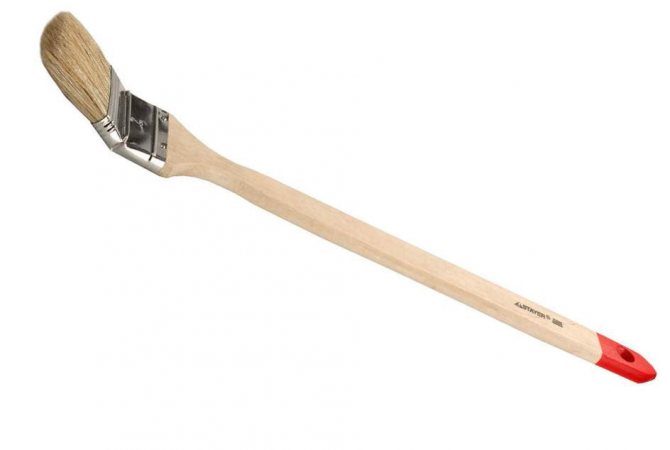

In the manufacture of the tool body, a high-quality metal alloy is used, which protects it from the effects of corrosion. Hair will not fall out of such a brush, as they are securely fixed.
The most comfortable use of the brush is made by the presence of a special hole on the handle. The tool can be hung for long-term storage. This product is manufactured in accordance with GOST. The Stayer Radiator Brush is a great choice for painting cast iron batteries.


Alkyd enamel
Alkyd enamel for heating radiators is available in a wide range of colors. Although it has a slight odor, it fades away quickly. In addition, such dyes are characterized by color fastness.
Depending on the basis, they are distinguished:
- Solvent based alkyd enamel for radiators... Such enamel has a very strong pungent odor, although the surface is beautiful and glossy. Most often, PF-115 enamel is purchased. Sometimes they choose enamel "Pesto" - its disadvantage is the need to tint with blue pigment in order to avoid yellowing.
- Organosilicon enamel is matte... As a rule, this group contains heat-resistant paints with a temperature threshold of up to 600 ℃. Sometimes they produce spray paints for heating radiators from this category - they are much easier to apply.
- Water Based Radiator Paint... These paints differ in their area of application. In particular, heat-resistant types of such enamel are used for radiators so that over time it does not darken. In white enamel, a titanium pigment is desirable. The main guideline when choosing a quality paint is its price.
Let's summarize
To achieve a productive result, you must use high-quality painting tools. If the task is to paint a cast-iron battery, then even this, not the most exciting, lesson can be performed comfortably.
Experts advise choosing several types of brushes. The Angled Radiator Brush is perfect for getting into tight spots. This instrument can be made from natural or synthetic material. The former provide a more uniform paint application. The latter are more durable. The Stayer radiator brush is a rational choice of a product designed in accordance with all the requirements of GOST.It is best to use products from a trusted manufacturer.
Methods for decorating old radiators
Today it is considered fashionable to return old things and devices to their original appearance or create a new "image" for them. Do-it-yourself cast-iron battery decor, for example, is not only a way to apply your abilities and make your fantasy come true, but also a reason to brag to your friends. As a rule, the work of removing the old coating takes longer than the further restoration of the product.
The easiest method is to paint cast iron batteries, and even in this you can show your individuality. If the interior requires a strict white color, then so be it, but as practice shows, more and more people prefer to give radiators a more joyful look, painting them in all colors of the rainbow.
Before starting work, the radiator must be cleaned and primed. To know exactly how many materials are required, you should calculate the area of a cast-iron heating radiator for painting. This is easy to do: the area of 1 section is multiplied by the number of sections in the device. To find out the area of the section itself, you will need a product data sheet, which indicates its length and height.
After the primer has dried, you can proceed directly to painting. Today, many colorants are sold as aerosols, which makes the job much easier, but you can do everything the old-fashioned way with a brush. To facilitate the work, craftsmen adapt a fur "mitten" for high-quality and uniform dyeing. To do this, you can take any piece of old fur, sew from it like a bag, and, putting on a rubber glove, and then a mitten, get to work.
Important: when choosing a paint, it is necessary to clarify how it tolerates high temperatures. If this is not done, then the selected agent will darken and become cloudy in the very first heating season, or, worse, it will release harmful substances when heated.
Another way to give old "accordions" a new and bright look is decoupage. Today, this is the most favorite method for decorating a cast-iron battery, creating truly stylish and individual designs on it with minimal effort and money. As a rule, available tools are suitable for this, for example:
- Matte paint for the background.
- Acrylic paints.
- Special paper for decoupage with a beautiful pattern.
- PVA and brushes.
- Heat resistant coating such as varnish.
The sequence of actions is as follows:
- Before painting cast-iron radiators, their surface is prepared for this in one of the ways described above. Apply matte paint and let dry.
- Dilute the glue, apply to the radiator and glue the pre-prepared decoupage parts. Allow to dry.
- If the plot requires the creation of a colored background or some additional drawings, then acrylic paints will come in handy.
- The last stage is the application of heat-resistant varnish.
The market currently offers a wide variety of special heat-resistant radiator stickers. By choosing a plot, you can create an individual style for each room.
Some craftsmen cover cast-iron radiators with false fireplaces. This addition to the interior looks interesting, creates coziness and supplies the necessary heat. It is possible to make a fake fireplace only if the battery is installed not under the window, but on the wall.
If the design requires that the radiators are not visible at all, special screens will come in handy, which you can make yourself or buy ready-made ones.

